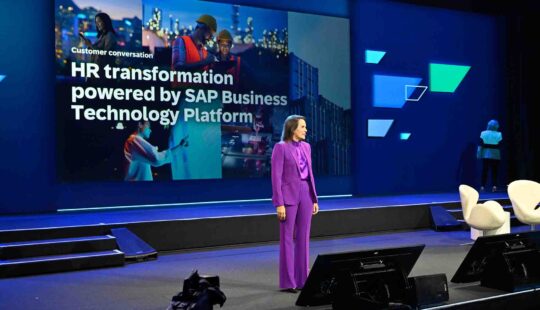Deskless workers are employees whose jobs are performed outside an office, virtual or otherwise. This includes frontline and field employees in retail, manufacturing, utilities, healthcare, transportation, and other industries. The people who perform deskless jobs directly impact our day-to-day lives. They make and deliver the food we eat and clothes we wear, ensure we have power and water in our homes, build and maintain the tools and machines we rely on, and provide care and protection for us and our families.
Most of the employees declared “essential workers” during the pandemic were in deskless jobs. Yet these essential employees receive little technology support compared to their desk-sitting colleagues.
Approximately 80% of the world’s employees do not sit at a desk, but only about 1% of enterprise software investment is focused on deskless workers. We rely on deskless workers for tasks that directly impact the health, happiness, and welfare of ourselves and our loved ones. Yet we give them very little job support compared to their desk-based colleagues. Fortunately, changes in the nature of work are driving investment to improve the employee experience for deskless workers.
Where We Are Now
A recent study by SAP provides insight into what it is like to be a deskless worker. The study notes the nature of deskless jobs varies depending on things like level of customer interaction, skills specialization, and work environment. When compared to the attitudes of desk-based employees, deskless workers tend to be much less satisfied with wages and bonuses, training and career development, opportunities to share ideas with management, and communication from the company about the business and the performance of themselves and their teams. The highest levels of dissatisfaction are among deskless workers in jobs associated with high turnover located outside of corporate offices, like retail service and health aids, or low levels of customer interaction, like manufacturing and distribution.
Statistics from this study paint a grim picture of the current state of deskless workers. “Only 33% of deskless workers feel comfortable talking to their manager about their salary. Forty-eight percent of deskless workers could not afford to lose the pay if they stayed home, and only 13% benefit from paid sick leave policies.” Only “61% of deskless workers in the United States intend to stay within their current job” although “69% of deskless workers would be less likely to leave their organization if employee communication would improve.” When confronted with statistics like these, it is little surprise that many industries find it difficult to hire and retain deskless workers.
Why It Is Changing
There are many reasons why deskless work is often seen as less enjoyable and fulfilling than desk-based work. It is often physically demanding, frequently pays less than desk-oriented jobs, and usually requires conforming to fixed work schedules. The fact that deskless workers are away from computers and offices also creates challenges in engaging and communicating with leaders and colleagues. However, three shifts in the nature of jobs are likely to profoundly improve the experience of deskless workers.
There Are No “Unskilled Jobs” in a Digital World
Historically, many deskless jobs were referred to as “unskilled” because they required no formal educational qualifications or requirements. Calling jobs unskilled led many companies to devalue their worth. Rather than investing in employee development, companies focused on using automation to make deskless jobs simpler to reduce costs of hiring and training workers. This focus on automation ultimately led to an interesting turning point that actually increased skill levels associated with deskless work. The role of deskless workers now often focuses on non-routine problems that machines cannot handle or involves doing things that require uniquely human traits and talents, such as displaying empathy. This is making deskless work much more skilled and is increasing the importance of training, developing, and retaining deskless workers.
Job Quality Is Driven by Employee Experience
As the pace of business competition increases, companies rely on deskless employees to be fully engaged in their work, doing things such as paying high levels of attention to manufacturing and maintenance tasks, delivering exceptional customer or patient care, and finding effective solutions to transportation or construction challenges. Employees do not do these things well if they feel stressed, overworked, or underappreciated.
There Are No Walls in a Hybrid World
The events of 2020 created a shift toward a more hybrid world that blends remote and on-site work experiences. This initially created tension between deskless workers and their desk-based colleagues who were able to work from home. As the world settles into a new hybrid approach, companies are now seeing opportunities to better engage all employees regardless of their physical location. This is leading to a greater sense of belonging among employees who work outside of corporate offices, which includes deskless workers.
These shifts create pressure on companies to improve employee experiences for deskless workers. How companies respond will determine whether they become opportunities for growth or threats to survival.
Where We Are Going
It has been said that technology is created when we need it. This is true when it comes to deskless work solutions. The following are three particularly valuable ways technology allows companies to rethink the nature of deskless work.
Create shared virtual workspaces where everyone has a voice.
Use mobile technology to ensure deskless workers have access to the digital work platforms that support hybrid work. Leverage these platforms to bring deskless and desk-based employees into a “shared workspace in the cloud.” And enable employee listening solutions that make it easy for deskless workers to express ideas, opinions, and experiences in a constructive and actionable manner.
Improve talent management and development in the flow of work.
Implement mobile-enabled coaching solutions that help managers engage, develop, and support deskless workers. Leverage micro-learning applications that allow deskless workers to integrate training and development activities into ongoing job activities.
Design more fulfilling jobs.
This involves addressing the lower wages and difficult work schedules historically associated with many deskless jobs. Two technology solutions are highly relevant to overcoming these challenges. First, integrated data solutions enable companies to determine how changes in compensation and scheduling impact operational business metrics such as sales, customer retention, manufacturing productivity, and safety incidents. These intelligent enterprise solutions make it possible to balance the costs of paying higher wages with the benefits of improved deskless worker experiences. Second, compensation management systems enable the design and delivery of service and sales-based commission plans that help ensure deskless workers are appropriately rewarded for their contributions.
Given how little technology investment deskless workers have received in the past, it is clear we can and should do more to support them. Paying greater attention to the needs of deskless workers will be critical to the business success of companies. The world is going through a major transition in reimagining the nature of what work is and how it should be performed. Rethinking deskless work, whether skilled or “unskilled,” is a critical part of this transformation.
Interested in hearing more about this topic? Be sure to register for an upcoming interactive panel discussion exploring the topic of deskless workers on August 11. Or, download the “Supporting the Deskless Workforce” white paper.
Steven T. Hunt, Ph.D., is part of Technology & Work within the SAP Innovation Office.



